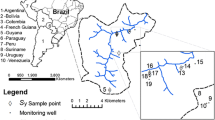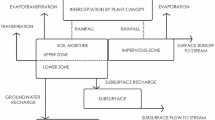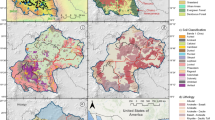Abstract
Using a water balance to estimate groundwater recharge through the use of remotely sensed evapotranspiration offers a spatial and temporal density of data that other techniques cannot match. However, the estimates are uncertain and therefore ground truthing of the recharge estimates is necessary. This study, conducted in the south-east of South Australia, demonstrated that the raw water-balance estimates of recharge had a negative bias of 45 mm/yr when compared to 190 recharge estimates using the water-table fluctuation method over a 10-year period (2001–2010). As this bias was not related to the magnitude of the recharge estimated using the water-table fluctuation method, a simple offset was used to bias-correct the water-balance recharge estimates. The bias-corrected recharge estimates had a mean residual that was not significantly different from an independent set of 99 historical recharge estimates but did have a large mean absolute residual indicating a lack of precision. The value in this technique is the density of the data (250-m grid over 29,000 km2). The relationship between the water-table depth and net recharge under different vegetation types was investigated. Under pastures, there was no relationship with water-table depth, as the shallow roots do not intercept groundwater. However, under plantation forestry, there was a relationship between net recharge and water-table depth. Net recharge under plantation forestry growing on sandy soils was independent of the water table at around 6 m depth but, under heavier textured soils, the trees were using groundwater from depths of more than 20 m.
Résumé
L’utilisation de bilan d’eau pour estimer la recharge des eaux souterraines via le recours à la mesure de l’évapotranspiration par télédétection fournit une densité spatiale et temporelle de données que d’autres techniques ne peuvent égaler. Toutefois, les estimations de recharge sont incertaines et par suite leur confirmation au sol est nécessaire. Cette étude, menée dans le Sud-Est du Sud de l’Australie, montre que le bilan d’eau estimé présente un biais négatif de 45 mm/an sur 190 estimations de recharge basées sur la méthode de fluctuation de la nappe sur une période de 10 ans (2001–2010). Comme l’incidence de ce biais n’a pas été rapportée à l’amplitude de la recharge estimée en utilisant la méthode de fluctuation de la surface de la nappe libre, une simple correction a été faite pour affranchir la recharge du biais. Ces estimations de la recharge corrigée présentent une moyenne résiduelle lissée ne différent pas de manière significative d’un ensemble indépendant de 99 estimations de recharges historiques mais les moyennes absolues résiduelles présentent un large écart indiquant un manque de précision. L’intérêt de cette technique est la densité des données (grille de 250 m sur 29,000 km2). La relation entre la profondeur de la nappe et la recharge nette pour différents types de végétation a été étudiée. Sous les pâturages, il n’y a pas de relation avec la profondeur de la nappe, car les racines de faible profondeur n’interceptent pas l’eau souterraine. Cependant, sous couvert forestier, il existe une relation entre la recharge nette et la profondeur de la nappe. La recharge nette sous les plantations forestières sur sol sableux est indépendante du niveau piézométrique situé à environ 6 m de profondeur, mais dans des sols plus texturés les arbres prélèvent l’eau souterraine à des profondeurs supérieures à 20 m.
Resumen
El uso de un balance de agua para estimar la recarga de agua subterránea a partir de la evapotranspiración obtenida por teledetección ofrece una densidad espacial y temporal de datos que otras técnicas no pueden brindar. Sin embargo, las estimaciones son inciertas y por lo tanto es necesaria una verificación de campo de la estimación de la recarga. Este estudio, realizado en el sudeste de Australia del Sur, demostró que la estimación del balance bruto de agua tuvo un sesgo negativo de 45 mm/año cuando se la comparó con la estimación de 190 de recarga calculada usando el método de las fluctuaciones del nivel freático en un período de 10 años (2001–2010). Como este sesgo no estaba relacionado con la magnitud de la recarga estimada de acuerdo al método de la fluctuación del nivel freático, se usó una compensación simple para corregir el sesgo de la estimación de recarga del balance de agua. La estimación de la recarga con el sesgo corregido tuvo una media residual que no fue significativamente distinta a conjunto independiente de 99 estimaciones históricas de recarga pero tenían un gran residuo absoluto medio indicando una falta de precisión. El valor en esta técnica es la densidad de los datos (una grilla de 250-m en 29,000 km2). Se investigó la relación entre la profundidad del nivel freático y la recarga neta bajo diferentes tipos de vegetación. Bajo pastura no había relación con la profundidad del nivel freático, dado por las raíces poco profundas que no interceptan el agua subterránea. Sin embargo, bajo plantaciones forestales, había una relación entre la recarga neta y la profundidad del nivel freático. La recarga neta bajo plantaciones forestales en crecimiento en suelos arenosos fue independiente del nivel freático hasta alrededor de 6 m de profundidad, pero en suelos de texturas más pesadas los árboles usan agua subterránea a profundidades de más que 20 m.
摘要
通过轻微感知的蒸发蒸腾量利用水平衡估算地下水补给量提供了其它技术不能匹配的数据时空密度。然而,估算数不确定,因此,需要脚踏实地的补给估算数。这项在南澳大利亚东南部进行的研究证明,原水平衡补给估算数与采用水位波动方法获得的10年期(2001–2010年)190个补给估算数相比有45 mm/yr的负偏差。因为这个偏差与采用水位波动方法估算的补给幅度无关,因此,采用简单的补偿校正了水平衡补给估算数的偏差。这个偏差校正过的补给估算数有平均残差,平均残差与99个历史的补给估算数独立集没有显著差别,但具有很大的平均绝对残差,表明缺乏精度。这项技术的价值就是数据的密度(29,000 km2内250-m的 网格)。研究了不同植被类型条件下水位深度和净补给量的关系。在牧场之下,与水位深度没有关系,因为浅根并不拦截地下水。然而,在人工林之下,净 补给量和水纹深度有关系。在生长在砂质土壤上的人工林之下,净补给量独立于大约6米深的水位之外,但在较重结构土壤下,树木汲取深度超过20 米的地下水。
Resumo
A estimativa da recarga da água subterrânea a partir de um balanço hidrológico calculado com os dados de evapotranspiração detetada remotamente permite definir uma densidade espacial e temporal dos dados que outras técnicas não conseguem relacionar. No entanto, as estimativas são incertas, e por isso é necessário autenticar a recarga no terreno. O presente estudo, realizado no sudeste da Austrália Meridional, demonstrou que a estimativa da recarga calculada através do balanço hídrico da água total apresenta um viés negativo de 45 mm/ano quando comparado com os 190 mm/ano de recarga estimados a partir do método de flutuação do nível da água aplicado a um período de 10 anos (2001–2010). Como o viés calculado não estava relacionado com a magnitude da recarga estimada pelo método de flutuação do nível da água, foi usado um método simples para corrigir o viés da estimativa da recarga a partir do balanço hidrológico. O viés da recarga estimada corrigida apresentou uma média residual semelhante à recarga estimada a partir de um conjunto de 99 dados históricos independentes, apresentando no entanto uma média residual absoluta elevada, indicativa de falta de precisão. O valor desta técnica está na densidade dos dados (malha de 250 m numa área total de 29,000 km2). Foi investigada a relação entre a profundidade do nível freático e a recarga total em áreas cobertas por diferentes tipos de vegetação. Em terrenos de pastagem não se observou qualquer relação com o nível freático, uma vez que as raízes pouco profundas não intercetam a água subterrânea. Já em terrenos ocupados por espécies arbóreas, foi possível estabelecer uma relação entre a recarga total e a profundidade do nível freático. Observou-se também que, nas plantações florestais em solos arenosos, a recarga total é independente do nível freático a partir de cerca de 6 m de profundidade, mas, em solos com texturas mais pesadas, as árvores usam a água subterrânea a partir de profundidades superiores a 20 m.














Similar content being viewed by others
References
ABARE-BRS (2010) Catchment scale land use mapping for Australia: update March 2010. Australian Bureau of Agricultural and Resource Economics, Bureau of Rural Sciences, Canberra, Australia
Allison GB, Hughes MW (1978) The use of environmental chloride and tritium to estimate total recharge to an unconfined aquifer. Aust J Soil Res 16:181–195
Anderson VG (1945) Some effects of atmospheric evaporation and transpiration on the composition of natural water in Australia (continued): 4. underground waters in riverless areas. J Aust Chem Inst 12:83–98
Bell DT (1999) Australian trees for the rehabilitation of waterlogged and salinity-damaged landscapes. Aust J Bot 47(5):697–716
Benyon RG, Theiveyanathan S, Doody TM (2006) Impacts of tree plantations on groundwater in south-eastern Australia. Aust J Bot 54(2):181–192
Brown K, Harrington G, Lawson J (2006) Review of groundwater resource condition and management principles for the Tertiary Limestone Aquifer in the south east of South Australia. Department of Water, Land and Biodiversity Conservation, Naracoorte, Australia
Brunner P, Bauer P, Eugster M, Kinzelbach W (2004) Using remote sensing to regionalize local precipitation recharge rates obtained from the chloride method. J Hydrol 294(4):241–250
Brunner P, Hendricks Franssen HJ, Kgotlhang L, Bauer-Gottwein P, Kinzelbach W (2007) How can remote sensing contribute in groundwater modeling? Hydrogeol J 15(1):5–18
Canadell J, Jackson RB, Ehleringer JR, Mooney HA, Sala OE, Schulze ED (1996) Maximum rooting depth of vegetation types at the global scale. Oecologia 108:583–595
Crosbie RS, Binning P, Kalma JD (2005) A time series approach to inferring groundwater recharge using the water table fluctuation method. Water Resour Res 41(1):1008
Crosbie RS, Jolly ID, Leaney FW, Petheram C (2010) Can the dataset of field based recharge estimates in Australia be used to predict recharge in data-poor areas? Hydrol Earth Syst Sci 14(10):2023–2038
Cuthbert MO (2010) An improved time series approach for estimating groundwater recharge from groundwater level fluctuations. Water Resour Res 46(9):W09515
Donohue RJ, McVicar TR, Roderick ML (2010) Assessing the ability of potential evaporation formulations to capture the dynamics in evaporative demand within a changing climate. J Hydrol 386(1–4):186–197
Eagleson PS (1982) Ecological optimality in water-limited natural soil-vegetation systems: 1. theory and hypothesis. Water Resour Res 18:325–340
Gee GW, Hillel D (1988) Groundwater recharge in arid regions: review and critique of estimation methods. Hydrol Process 2(3):255–266
Glenn EP, Doody TM, Guerschman JP, Huete AR, King EA, McVicar TR, Van Dijk AIJM, Van Niel TG, Yebra M, Zhang Y (2011) Actual evapotranspiration estimation by ground and remote sensing methods: the Australian experience. Hydrol Process 25(26):4103–4116
Guerschman JP, Van Dijk AIJM, Mattersdorf G, Beringer J, Hutley LB, Leuning R, Pipunic RC, Sherman BS (2009) Scaling of potential evapotranspiration with MODIS data reproduces flux observations and catchment water balance observations across Australia. J Hydrol 369(1–2):107–119
Harrington N, Lamontagne S (Editors) (2013) Framework for a regional water balance model for the South Australian Limestone Coast region. Goyder Institute for Water Research, Adelaide, Australia
Harrington N, Woods J, Turnadge C, Davies P, Li C (2013) Overview of the study area. In: Harrington N, Lamontagne S (eds) Framework for a regional water balance model for the South Australian Limestone Coast region. Goyder Institute for Water Research, Adelaide, Australia
Healy RW, Cook PG (2002) Using groundwater levels to estimate recharge. Hydrogeol J 10(1):91–109
Herczeg AL, Leaney FWJ, Stadler MF, Allan GL, Fifield LK (1997) Chemical and isotopic indicators of point-source recharge to a karst aquifer, South Australia. J Hydrol 192(1–4):271–299
Jeffrey SJ, Carter JO, Moodie KB, Beswick AR (2001) Using spatial interpolation to construct a comprehensive archive of Australian climate data. Environ Model Softw 16(4):309–330
Jones DA, Wang W, Fawcett R (2009) High-quality spatial climate data-sets for Australia. Aust Meteorol Oceanogr J 58(4):233–248
Kalma J, McVicar T, McCabe M (2008) Estimating land surface evaporation: a review of methods using remotely sensed surface temperature data. Surv Geophys 29(4–5):421–469
Kennett-Smith A, Cook PG, Walker GR (1994) Factors affecting groundwater recharge following clearing in the south western Murray Basin. J Hydrol 154(1–4):85–105
Keywood MD, Chivas AR, Fifield LK, Cresswell RG, Ayres GP (1997) The accession of chloride to the western half of the Australian continent. Aust J Soil Res 35:1177–1189
Kim JH, Jackson RB (2012) A global analysis of groundwater recharge for vegetation, climate, and soils. Vadose Zone J 11(1). doi:10.2136/vzj2011.0021RA
King E, van Niel T, van Dijk A, Wang Z, Paget M, Raupach T, Guerschman J, Haverd V, McVicar T, Miltenberg I, Raupach M, Renzullo L, Zhang Y (2011) Actual evapotranspiration estimates for Australia: intercomparison and evaluation. CSIRO: Water for a Healthy Country National Research Flagship, Canberra, Australia
Lamontagne S, Taylor A, Herpich D, Hancock G (2013) Groundwater discharge to the marine environment. In: Harrington N, Lamontagne S (eds) Framework for a regional water balance model for the South Australian Limestone Coast region. Goyder Institute for Water Research, Adelaide, Australia
Leaney FW, Herczeg AL (1995) Regional recharge to a karst aquifer estimated from chemical and isotopic composition of diffuse and localised recharge, South Australia. J Hydrol 164(1–4):363–387
Leaney F, Crosbie R, O’Grady A, Jolly I, Gow L, Davies P, Wilford J, Kilgour P (2011) Recharge and discharge estimation in data poor areas: scientific reference guide. CSIRO: Water for a Healthy Country National Research Flagship, Canberra, Australia
Meinzer OE, Stearns ND (1929) A Study of groundwater in the Pomperaug Basin, Conn. with special reference to intake and discharge. US Geol Surv Water Supply Pap 597B
Műnch Z, Conrad JE, Gibson LA, Palmer AR, Hughes D (2013) Satellite earth observation as a tool to conceptualize hydrogeological fluxes in the Sandveld, South Africa. Hydrogeol J 21(5):1053–1070
Mustafa S, Lawson JS (2002) Review of Tertiary Gambier Limestone aquifer properties, lower south-east, South Australia. Department of Water, Land and Biodiversity Conservation, Naracoorte, SA, Australia
O’Grady AP, Carter JL, Bruce J (2011) Can we predict groundwater discharge from terrestrial ecosystems using existing eco-hydrological concepts? Hydrol Earth Syst Sci 15(12):3731–3739
Osei-Bonsu K, Barnett SR (2008) Padthaway Salt Accession Study, phase 3E: refinement of Naracoorte Ranges salt accession models and study of groundwater flow on Padthaway Flats (Draft). Department of Water, Land and Biodiversity Conservation, Adelaide, Australia
Petheram C, Walker G, Grayson R, Thierfelder T, Zhang L (2002) Towards a framework for predicting impacts of land-use on recharge: 1. a review of recharge studies in Australia. Aust J Soil Res 40(3):397–417
Scanlon BR, Healy RW, Cook PG (2002) Choosing appropriate techniques for quantifying groundwater recharge. Hydrogeol J 10:18–39
Scanlon BR, Keese KE, Flint AL, Flint LE, Gaye CB, Edmunds WM, Simmers I (2006) Global synthesis of groundwater recharge in semiarid and arid regions. Hydrol Process 20(15):3335–3370
SENRMB (2013) Water allocation plan for the Lower Limestone Coast Prescribed Wells area. South East Natural Resources Management Board, Adelaide, Australia
Shah N, Nachabe M, Ross M (2007) Extinction depth and evapotranspiration from ground water under selected land covers. Ground Water 45(3):329–338
Smith M, Allen RG, Monteith JL, Perrier A, Pereira LS, Segeren A (1992) Expert consultation on revision of FAO methodologies for crop water requirements. Food and Agriculture Organisation, Rome
Soylu ME, Istanbulluoglu E, Lenters JD, Wang T (2011) Quantifying the impact of groundwater depth on evapotranspiration in a semi-arid grassland region. Hydrol Earth Syst Sci 15(3):787–806
Szilagyi J, Jozsa J (2013) MODIS-aided statewide net groundwater-recharge estimation in Nebraska. Ground Water 51(5):735–744
Szilagyi J, Zlotnik VA, Gates JB, Jozsa J (2011) Mapping mean annual groundwater recharge in the Nebraska Sand Hills, USA. Hydrogeol J 19(8):1503–1513
Szilágyi J, Kovács Á, Józsa J (2012) Remote-sensing based groundwater recharge estimates in the Danube-Tisza Sand Plateau Region of Hungary. J Hydrol Hydromech 60(1):64–72
Szilagyi J, Zlotnik VA, Jozsa J (2013) Net recharge vs. depth to groundwater relationship in the Platte River Valley of Nebraska, United States. Ground Water 51(6):945–951
Walker G, Jolly I, Stadter M, Leaney F, Stone W, Cook P, Davie R, Fifield L (1987) Estimation of diffuse recharge in the Naracoorte Ranges region, South Australia: an evaluation of chlorine-36 for recharge studies. Australian Water Research Advisory Council, Canberra, Australia
Wohling D (2008) Minimising salt accession to the south east of South Australia: the border designated area and hundred of Stirling salt accession projects, vol 2—analytical techniques, results and management implications. DWLBC report 2008/23. South Australian Department of Water, Land and Biodiversity Conservation, Adelaide, Australia
Wood WW (1999) Use and misuse of the chloride-mass balance method in estimating ground water recharge. Ground Water 37(1):2–3
Wood C (2010) South East National Water Initiative Sub Program 1.1: improved estimates of groundwater recharge in south east South Australia. DWLBC report (Draft). South Australian Department of Water, Land and Biodiversity Conservation, Adelaide, Australia
Acknowledgements
Funding for this work was provided by the Goyder Institute for Water Research. The water level measurements used in the WTF estimates of recharge were provided by the Department of Environment, Water and Natural Resources in South Australia and the Department of Environment and Primary Industries in Victoria. We are also grateful for the thoughtful reviews of Kate Holland, Tanya Doody and three anonymous reviewers which helped improve the manuscript.
Author information
Authors and Affiliations
Corresponding author
Rights and permissions
About this article
Cite this article
Crosbie, R.S., Davies, P., Harrington, N. et al. Ground truthing groundwater-recharge estimates derived from remotely sensed evapotranspiration: a case in South Australia. Hydrogeol J 23, 335–350 (2015). https://doi.org/10.1007/s10040-014-1200-7
Received:
Accepted:
Published:
Issue Date:
DOI: https://doi.org/10.1007/s10040-014-1200-7




